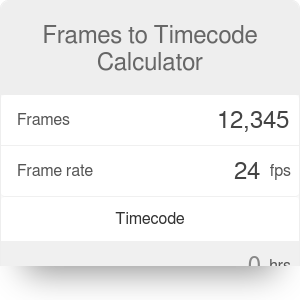
Pressing the Reset event list and tempo search parameters button will restore the default settings in the timing event series (00:00:00:00) and tempo search domain.The overall timing error is the Root-Mean-Square Error (RMSE) value E RMS (see the table cells with label E t). The overall error that was used for ranking the tempo solutions is shown in the bottom row, as is the resulting tempo in.

Timecode calculator using normal time movie#
The time resolution is 50 milliseconds i.e., the maximum timing error between movie event and musical beat is 25 milliseconds (i.e., accurate to 1-2 frames).
Timecode calculator using normal time code#

With many closely spaced events the solution will yield unlikely high tempos. Tempo range limits and step size are specified as metronome markings in beats-per-minute (BPM) units.The three best matching tempo values are shown on the table bottom row (three coloured cells). Press the Find best tempo fit button and see the results. The first hit point determines the initial time offset. Specify the timing of cue event hit points in the first column pull-down menus.Finally, tick a Meter (time signature) radio button setting. Time code will enable 50 ms time steps, choose between 24, 25 or 30 FPS rates. This will modify the cue hit point pull-down menus in the table accordingly. Tick the radio button for either SMPTE time code or frames. Choose the Tempo range and step size in BPM from the pull-down menus. Musical beats and timing errors are shown in the table cells.

Number of event markers on a film cue timeline. This JavaScript GUI provides a musical tempo calculator that best fits a


 0 kommentar(er)
0 kommentar(er)
